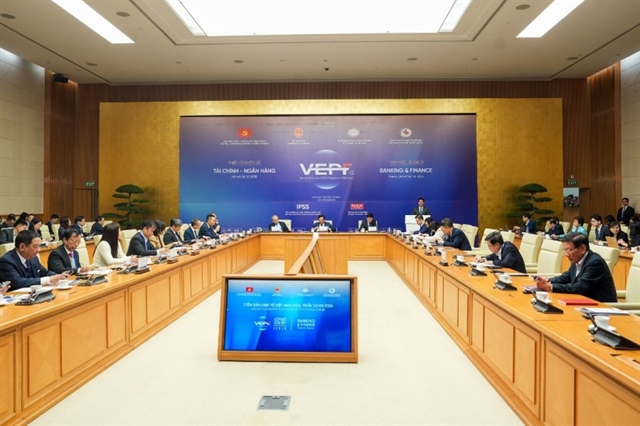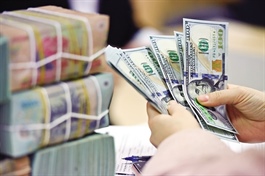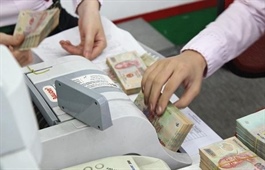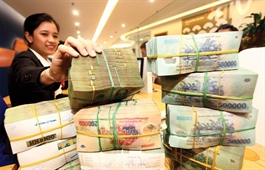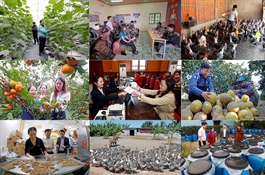Next stage reached in carbon credit sphere
Next stage reached in carbon credit sphere
International cooperation policies are essential to develop the carbon credit market in Vietnam, but the market as a whole still has to be built in an effective manner in terms of legality and process.
In the last days of December, a discussion on the opportunities and challenges in Vietnam’s carbon credit market took place in Hanoi.
Many companies around the world have begun to look into credits to offset their emissions as a way to support their net-zero goals. As it stands, the global carbon credit market is too small to fully take on reducing companies’ impacts on the environment.
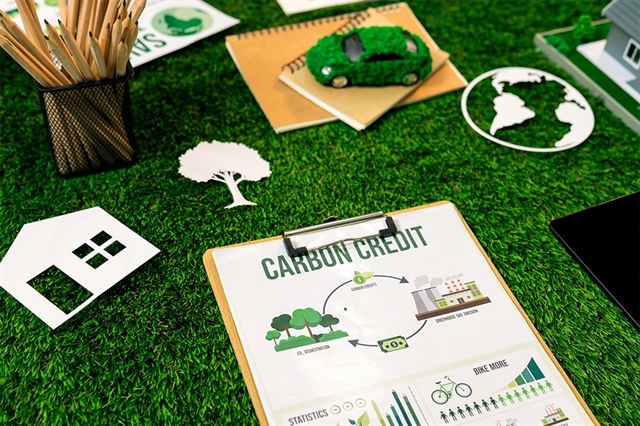
Next stage reached in carbon credit sphere, Photo: Shutterstock |
However, experts said the voluntary carbon market has the potential to drive billions of US dollars over the coming decade into climate solutions. Nguyen Dinh Tho, president of the Institute of Strategy and Policy on Natural Resources and Environment, said at the discussion that while the compliance market was the foundation for countries to develop carbon credits, in Vietnam, the voluntary one is still limited.
“Although it does not have the same great potential as Brazil or other countries in the Amazon region, Vietnam still has the opportunity to develop the carbon credit market in agriculture and forestry,” he said.
Tho emphasised that the development depends largely on state policies and the ability to connect the two markets.
For example, a project developing one million hectares of low-emission rice, initiated by the Ministry of Agriculture and Rural Development (MARD) at the end of 2023, aims to gain about $100 million in carbon credits by 2030.
“The greatest economic benefit of the scheme is not only in selling them but also in reducing input costs through more efficient production processes and building a brand for emission-reducing rice,” Tho said.
The project is expected to increase the value of Vietnam’s rice industry by about $857 million per year, including cutting rice production costs by $388 million, increasing selling prices by $286 million, utilising waste and by-products at $82 million, and selling carbon credits.
Effective management
However, Vietnam does not have sufficient legal mechanisms, with credits still mainly sold on the primary market, with low profits but high risks. Under a carbon trading programme, the primary market includes the first events in which a carbon allowance changes hands for a price – usually an auction.
Many businesses can sell carbon credits at the default price of $10. But in 2024, Vietnam only earned $51.5 million by selling 10.3 million forest carbon credits, equivalent to $5 each.
In Quang Binh, one of the provinces participating in carbon credit transfer, revenue is only $7-8 per ha, much lower than the price of $100 in low-emission rice project.
However, Tho said that it was necessary to carry out inventory, reporting, and confirmation of carbon credits, which requires large investments in technology and costs. The application of digital transformation, clouding, and blockchain is the key to effectively managing and exploiting credits, he added.
“We may face numerous challenges if focusing only on carbon credits from forestry. Therefore, the connection of the compulsory and voluntary markets, along with multilateral cooperation under Article 6 of the Paris Agreement, will increase the value of Vietnam’s carbon credits in the international market,” Tho said.
Economist Dinh Trong Thinh emphasised that if the existing potential was well utilised, Vietnam can gain significant benefits from carbon credits.
“Publicity is necessary so that people understand and implement measures to save energy and reduce emissions in daily life and production. This is not only a solution to improve economic efficiency in the short term but contributes to sustainable development and building a green future.”
Thinh said that for Vietnam to compete effectively in the international carbon credit market, it was necessary to do appraised quality assurance activities in the production, business, and supply of carbon credits. Initiatives need to be built focused on long-term sustainable development.
“The development of CO2 absorption activities such as agriculture, forestry, renewable energy, coastal afforestation, and environmental treatment should be included in the master plan. These are core issues that management agencies need to address,” Thinh said.
Localities also need to comply with the master plan, promote sustainable development, save resources, reduce the use of non-renewable materials, and optimise CO2 absorption, Thinh added.
Overlaps must be erased
Last November, the COP29 conference in Azerbaijan closed with an agreement on the carbon market, but discussions on transitioning away from fossil fuels did not receive consensus.
For Vietnam, the market is an important part of the strategy to reduce greenhouse gas emissions and achieve net-zero emissions by 2050.
Tran Nhat Quang, director of Investment and Research at NAI Vietnam, said that low carbon absorption efficiency was a technical barrier that had not been fully tackled. The amount of CO2 that one ha of forest absorbs annually depends on the type of forest, age, tree density, and environmental conditions.
Natural forests can absorb 37-87 tonnes of CO2 per ha, planted forests 12-131 tonnes of CO2, and mangrove forests 6-91 tonnes. The Cuc Phuong National Forest, for example, can absorb just over 1,000 tonnes of CO2 per ha annually.
“Research showed that one ha of forest in Vietnam can only absorb an average of 10-20 tonnes of CO2 per ha every year, much lower than initial expectations, due to the decline in natural forest area and the ineffectiveness of most planted forests in absorbing carbon,” Quang said.
In addition, most of the area of primary natural forests are located in remote areas, owned by ethnic minorities, so it is difficult to access, propaganda, and support for forest care, and restoration. On the other hand, planted forests are mainly single-species industrial forests, of young age, so they do not absorb carbon as much as natural forests.
“Even for businesses operating in the forestry sector, the revenue from selling carbon credits is limited,” Quang said.
Tran Minh Hai, vice president of the Institute for Public Policy and Rural Development under the MARD emphasised that carbon appraisal was not cheap. “The legal corridor, processing, appraisal, and certification procedures for carbon credits currently have many overlaps, causing the transaction registration time to be prolonged, the total cost can be up to $8 each,” Hai said.
Currently, Vietnam is still building a legal system and mechanism to develop carbon credit trading in the secondary market.
“This not only limits the ability to increase the value but also eliminates the opportunity to profit from fluctuations in global supply and demand. As long as businesses still have demand, the price of credits will increase because demand is greater than supply, and speculators will appear,” said Quang from NAI Vietnam.
“The number of production facilities for customers in developed countries is also considerable. They will have to buy carbon credits to compensate massively, and the price war will be accelerated and in the hands of speculators,” Quang added.
|
Greenhouse gas mitigation: The story so far Vietnam’s total annual greenhouse gas (GHG) emissions are increasing at among the fastest rates in the world, ranking sixth among countries heavily affected by extreme weather. Over the years, the nation has participated in many international commitments, such as the UN Framework Convention on Climate Change, the Kyoto Protocol, and the Paris Agreement. To implement these commitments, the Law on Environmental Protection in 2020 noted that organising and developing the domestic carbon market is one of the contents of GHG emission mitigation. In 2021, Vietnam committed to net-zero by 2050, reducing methane emissions from human activities in all sectors by at least 30 per cent compared to 2020 emissions by 2030. In addition, the updated 2022 Nationally Determined Contribution targets require a 15.8 per cent reduction of GHGs with domestic resources and 43.5 per cent with international support by 2030. A 2022 decree on the issue pointed out the objectives and methods of GHG emission mitigation. The exchange of GHG emission quotas and carbon credits will have to be carried out on the carbon credit trading platform, and domestic carbon market. Additionally, the national climate change strategy encourages resources for climate change response, development of financial mechanisms and carbon markets, and promotion of investment shift for low-emission economic development. It also promotes state resources and attraction of resources from organisations, enterprises, international organisations, and public-private partnerships. Meanwhile, the National Green Growth Strategy towards 2030 and beyond highlights the establishment of a carbon market towards the synchronous development of a mechanism for exchanging emission rights in line with market-oriented mechanisms. Commodities on the Vietnam carbon market are expected to be GHG emission quotas allocated by the Ministry of Natural Resources and Environment, or combined with auctions for facilities on the list of those required to inventory GHGs; as well as carbon credits certified by the ministry to be traded on the carbon credit trading platform, made from domestic and international credit creation programmes and projects. Over the next three years, a carbon credit trading platform will be piloted, and evaluated results, while the legal framework and technical infrastructure will be improved. From 2029, the carbon credit trading platform will officially operate. Source: Ministry of Finance |




